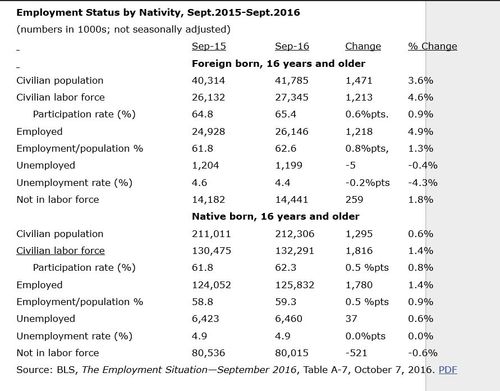
National Data | Immigrant Displacement Of American Workers At Second-Highest Level In Obama Era (Last Month Was Highest)
10/08/2016
Friday’s release of jobs data for September showed unemployment up and weak job growth — but more significantly, in a development apparently only tracked by VDARE.com, immigrant displacement of American workers is now at its second-highest level for the Obama years. (August was the highest). Additionally, there’s continued evidence that an unreported immigration surge is underway, right in time for the election season.
Rarely has the relationship between the immigration and employment issues been as clear. Over the past 12 months (September 2015 to September 2016) seasonally unadjusted BLS data show:
- The immigrant population of working age grew by 1.471 million, or 3.6%; the corresponding native-born American population grew by 1.3 million, up a mere 0.6%.
- Immigrant employment rose by 1.218 million, a 4.9% gain, while native-born American workers gained 1.780 million positions, a gain of only 1.4%.
- The number of unemployed native-born Americans rose by 37,000, a gain of 0.6%, while the number of unemployed immigrants shrank by 5,000 — a 0.4% decline.
- The immigrant unemployment rate fell from 4.6% to 4.4%; the native-born jobless rate remained at 4.9%.
In September:
- Total Household Survey employment rose by 354,000, up by 0.23%
- Native-born American employment rose by 311,000 up by 0.25%
- Foreign-born employment rose by 43,000, up by 0.16%
Native-born American employment growth is represented by the black line, immigrant employment growth is in pink, and NVAWDI — the ratio of immigrant to native-born job growth — is in yellow. The index starts at 100.0 in January 2009 for both immigrants and native-born Americans, and tracks their employment growth since then.
From January 2009 through September 2016:
- Immigrant employment rose by 4.498 million, or by 20.8%. The immigrant employment index rose from 100.0 to 120.8.
- Native-born American employment rose by 5.249 million, up by 4.4%. The native-born American employment index rose from 100.0 to 104.4.
- NVDAWDI (the ratio of immigrant to native-born employment growth indexes) rose from 100.0 to 115.7. (100X (120.8/104.4))
The foreign-born share of total U.S. employment has risen steadily, albeit erratically, throughout the Obama years:
In February 2009, President Obama’s first full month in office, 14.972% of all persons working in the U.S. were foreign-born. The foreign-born share in September was 17.204%, the second highest among the 93 months of Mr. Obama’s administration. The Obama era high, 17.216%, was set in September.
Six of the 10 worst months for native-born workers in the Obama years (measured by the share of jobs held by immigrants) have occurred in 2016.
The foreign-born share of total employment in September was 2.23 percentage points above the level recorded in February 2009. With total employment now at 152.0 million, this implies that Obama-era immigration may have pushed as many as 3.39 million native-born Americans onto the unemployment rolls since then.
A detailed snapshot of American worker displacement over the past year is seen in the Employment Status of the Civilian Population by nativity table published in the monthly BLS Report.

Over the last 12 months (September 2015 to September 2016):
- Immigrant employment rose by 1.218 million, up 4.9%, while native-born American employment rose 1.780 million, up by 1.4%. Immigrant employment grew 3.5-times faster than native-born American employment.
- The number of unemployed immigrants fell by 0.4%, while the number of native-born unemployed rose by 0.6%.
- Unemployment rates dropped 4.3% for immigrants and remained unchanged for native-born Americans.
- The Labor-force participation (LFP) rate, a sign of worker confidence, rose by 0.9% for immigrants and by 0.8% for native-born Americans. Advantage immigrants.
Once again the labor force and population numbers give us pause. BLS estimates that the immigrant labor force grew by 1.213 million, a 4.6% gain, while the native-born labor force grew by 1.816 million, or by1.4%.
Other things equal, faster labor force growth should portend higher unemployment rates — but this calculus does not seem to apply to immigrants. By settling for wages which most native-born workers find unacceptable, they have achieved lower unemployment despite a rapidly growing labor force.
The winners — besides the immigrants themselves — are business elites and others in the top 1% who receive income from their capital rather than their labor.
The population figures are even more problematic. The number of working age immigrants rose 1.471 million in the 12 months September 2015 to September 2016. That is larger than the commonly cited figure of 1 million per year for net legal immigration of all ages.
Are illegals filling the gap? Or refugees that we do not know about?
Edwin S. Rubenstein is President of ESR Research Economic Consultants.
